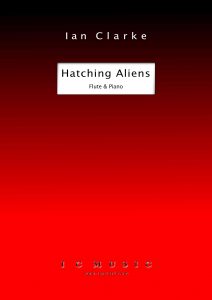Hatching Aliens

Hatching Aliens – (flute & piano) [advanced – requires open-holes and preferably B foot]
In three movements – ‘Something is there!’, ‘Alien Chill Out/Blue Alien’, ‘The Fear Returns – Battle Tempo’. Approx. 16-17mins in duration. Emergent edition published in 2010.
Hatching Aliens is a journey of the imagination. It is not modelled on any particular previous work either by myself or other composers. However, it’s primal explorations perhaps have some echoes of the feelings of Stravinsky’s Rite of Spring along with hints of darkness of the film Alien whilst also seeking some resolutions, dialogue and empathies in, and with, the unknown. As with other works it has an existential dimension; certainly it reaches into origins, corners and twists of reality with for example the quarter-tones being used partly as a metaphor for peering inbetween. Our world can be curiously alien, frightening and strangely beautiful. Hatching Aliens themselves would presumably be fascinating, alluring and earth shatteringly scary all at once …. what would we learn about ourselves?
The opening section that begins inside the flute is the seed of the work. From here the work has taken on a life of its own which has always been intrinsically connected with the imaginations of the title.
This work was previewed in the summer of 2008 at flute courses in St Andrews, Scotland and Woldingham, England before it’s official premiere at the British Flute Society Convention in Manchester August 2008.
The USA premiere was at the National Flute Association’s Convention in New York City August 2009.
Both convention performances were by Ian Clarke and the inimitable Tim Carey.
Overview of Techniques:
As the score is intended to be self-sufficient it is inevitable that a work that uses the extended flute will sometimes look more complex on the page than parts of it might be to perform. At all times it is worth bearing in mind that this was brought into being ‘off the page’, ‘within the instruments’ and of course ‘in the imagination’. Not an original way of looking at things but worth restating nonetheless. Most of the techniques used here are used in previous works both by myself and other composers so there is a context and body of knowledge from which to draw. However don’t worry, it is anticipated that many players will be not be familiar with a number of these techniques and indeed only a very few may have used them all. Therefore, a technique guide is given in the edition.
The opening:
These opening sounds are based on manipulating the jet whistle which is achieved by covering the entire embouchure hole and blowing directly into the flute. The triangular note-heads indicate when to exhale and inhale. Furthermore the sound can be modified by making different shapes inside the mouth e.g. exhaling on an exaggerated ‘heee’ or inhaling on “aw-ee-aw-ee-aw-ee-aw-ee” as in bar 4. Along with the indicated different angles of the flute in the mouth this can accentuate different partials in the sound. More detailed steps are shown below.
Quarter-Tones:
There are suggested fingerings throughout. They are not repeated on every occassion as it is much more efficient for the learning process if they are assimilated without referencing the diagrams more than is necessary. It is recommended that each fingering be taken ‘off the page’ and experimented with in a variety of ways – the usual ‘less haste, more speed’ maxim is applicable here. Advanced players often find this difficult … 🙂 Fingerings are shown horizontally or vertically for layout purposes.
Glissandi:
It is worth referencing some of the guide videos for ‘Touching the Ether’ at www.ianclarke.net as the motions used here will give the idea of how to do the glissandi. There is fluid and free motion that can be achieved. The important alternative fingerings are given. Note that many of the notes are not played with the normal fingerings but with alternative fingerings using the rings only. The notes with diamond note-heads use the non-standard fingerings indicated. The alternative other-worldly ‘singing alien’ sound can be further cultivated by colouring with appropriate vowels and vibrato. The necessary fingerings for the quarter-tone notes and grace-notes have been indicated either in this movement or the 1st movement.
Ian Clarke
May 2010